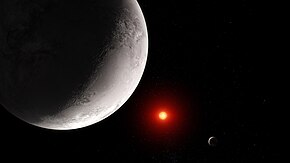 Artist's impression of TRAPPIST-1c (June 2023) with TRAPPIST-1b in the background | |
| Discovery[1] | |
|---|---|
| Discovered by | Michaël Gillon et al. |
| Discovery site | TRAPPIST |
| Discovery date | May 2, 2016 |
| Transit | |
| Orbital characteristics[2] | |
| 0.01580±0.00013 AU | |
| Eccentricity | 0.00654±0.00188[3] |
| 2.421937±0.000018 d | |
| Inclination | 89.778°±0.118° |
| 282.45°±17.10°[3] | |
| Star | TRAPPIST-1[4] |
| Physical characteristics[2] | |
| 1.097+0.014 −0.012 R🜨 | |
| Mass | 1.308±0.056 M🜨 |
Mean density | 5.447+0.222 −0.235 g/cm3 |
| 1.086±0.043 g 10.65±0.42 m/s2 | |
| Temperature | 339.7±3.3 K (66.6 °C; 151.8 °F, equilibrium)[5] 380±31 K (107 °C; 224 °F, surface)[6] |
| Atmosphere | |
| Composition by volume | None or extremely thin[6][7][8] |
TRAPPIST-1c, also designated as 2MASS J23062928-0502285 c, is a mainly rocky exoplanet orbiting around the ultracool dwarf star TRAPPIST-1, located 40.7 light-years (12.5 parsecs) away from Earth in the constellation Aquarius. It is the third most massive and third largest planet of the system, with about 131% the mass and 110% the radius of Earth.[2] Its density indicates a primarily rocky composition, and observations by the James Webb Space Telescope announced in 2023 suggests against a thick CO2 atmosphere, however this does not exclude a thick abiotic oxygen-dominated atmosphere as is hypothesized to be common around red dwarf stars.[citation needed]
- ^ Cite error: The named reference
Gillon2016was invoked but never defined (see the help page). - ^ a b c Cite error: The named reference
Agol2021was invoked but never defined (see the help page). - ^ a b Cite error: The named reference
Grimm2018was invoked but never defined (see the help page). - ^ Cite error: The named reference
vangrootel2017was invoked but never defined (see the help page). - ^ Cite error: The named reference
Ducrot2020was invoked but never defined (see the help page). - ^ a b Cite error: The named reference
Zieba2023was invoked but never defined (see the help page). - ^ Cite error: The named reference
JWST-20230619was invoked but never defined (see the help page). - ^ Cite error: The named reference
Radica2024was invoked but never defined (see the help page).